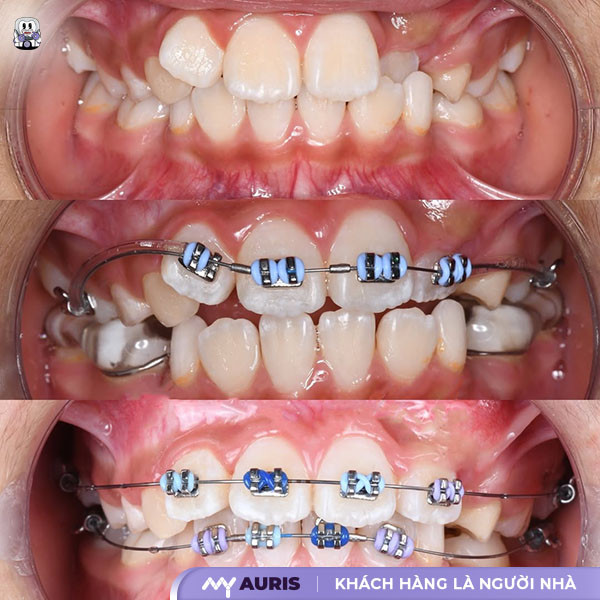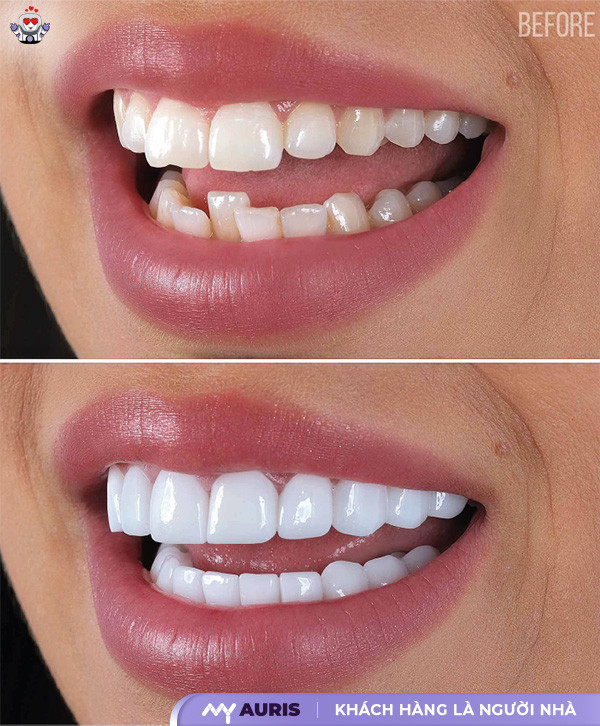The remarkable progress in modern dental technology has brought about many advanced treatments for dental problems, especially disorganized teeth – a common problem that affects aesthetics and health. However, many people are still confused when choosing the most effective and appropriate correction method.
In this article, we will learn in detail about disorganized teeth, the causes of this condition and the modern dental treatment methods being applied. Let’s explore the optimal solutions to have beautiful teeth, improve the quality of life and be confident with a smile every day.
What are misaligned teeth? Is it dangerous?
Misaligned teeth is a condition in which the teeth in the jaw do not lie in a straight line on the jaw. Instead of being evenly aligned in a standard bite, the teeth may be crowded, misaligned, protrude outward, or be pushed inward. This is a common form of malocclusion, common in both children and adults.
There are three common levels of teeth misalignment: mild (little crowding of teeth, mild misalignment), moderate (rotated teeth, a lot of crowding), and severe (severe misocclusion, misalignment of the entire jaw). Determining the correct level of misalignment requires the support of an orthodontist and modern diagnostic tools such as CT Cone Beam X-rays.
Many people think misaligned teeth only affect appearance. But in reality, the consequences of messy teeth are more profound:
Difficult to clean and susceptible to dental diseases: Crowded teeth create small gaps in the teeth that are difficult to clean. Bacteria that accumulate over time will cause tooth decay, gingivitis and periodontitis. In addition, ineffective brushing also damages tooth enamel and affects the pulp.
Causes bite misalignment, affecting chewing function: When teeth are not in the correct position, the bite is about to break. This makes chewing unbalanced, easily causing jaw muscle fatigue, headaches, and even jaw misalignment if not treated promptly.
Impacts on pronunciation and facial aesthetics: Incisors growing in the wrong position can affect the pronunciation of sounds like “s”, “ch”, “x”. In addition, uneven teeth also make the face unbalanced, easily making the patient lack confidence in communication.
Effects facial bone development (in young children): In children, misaligned teeth if not corrected early can change the direction of development of the craniofacial skeletal system. This increases the risk of needing orthodontic surgery as an adult.
Increases treatment costs if left for a long time: The longer it is left, the more severe the misalignment becomes. At that time, treatment methods such as braces or Invisalign will take longer, cost more and the restoration results are less stable.

Causes of misaligned, crowded teeth
This condition can come from many different causes, including weakness congenital factors, deviations in tooth development, or impacts from daily living habits. For effective treatment, it is necessary to clearly understand the specific cause of this deviation.
Genetic and congenital factors
One of the common causes is genetic factors. If parents have a narrow jaw, crowded teeth or a misaligned bite, their children are at high risk of experiencing the same condition. The genetic structure of the craniofacial system can cause teeth to not have enough space to grow evenly, leading to misalignment or rotation. In many cases, the orthodontist needs to evaluate the overall structure of the upper and lower jaw through Cone Beam CT scans to clearly determine.
Early loss of baby teeth or baby teeth that last too long
Baby teeth act as placeholders for permanent teeth. If baby teeth fall out too early or persist long after the age of tooth replacement, the jaw arch will be affected. At that time, permanent teeth may grow in the wrong direction, be crowded, grow underground or have a wrong bite. This is a common cause in children who do not closely monitor the tooth replacement process.
Wisdom teeth growing in the wrong position
Wisdom teeth (tooth number 8) when growing crookedly can cause Strong force pushes on the adjacent molars, causing the entire teeth to shift. This is especially common in people with small jaws or weak periodontal systems. In these cases, doctors often prescribe wisdom tooth extraction before orthodontic treatment.
Bad habits since childhood
Habits of sucking fingers, holding pacifiers for too long, pushing Swallowing the tongue or grinding the teeth at night can cause incorrect bite and directly affect the direction of tooth growth. If not intervened early, these habits will lead to teeth growing in the wrong bite, creating misaligned teeth that are difficult to control.
The jaw does not have enough room for teeth to grow
Another common cause is a narrow or unevenly developed jaw. When there is not enough space in the jaw, the teeth will be forced to cHen wishes each other to grow. This causes teeth to grow haphazardly, rotate crookedly or lie in the wrong position. This case is often treated by orthodontists with braces or Invisalign clear braces combined with jaw expansion if necessary.
Current methods to fix misaligned teeth
In most cases, if teeth are severely misaligned, have an underbite or have teeth with a complete malocclusion, braces are still the most effective solution. However, if the teeth are slightly misaligned and do not affect the bite, the patient can consider porcelain crowns or porcelain veneers to save time while still improving appearance. Below are three commonly applied methods.
Orthodontic braces – comprehensive intervention
Braces are the original tooth straightening solution, Comprehensively adjust the standard bite and guide teeth to the ideal position on the jaw. This method is suitable for severe misaligned teeth, severe crowding, underbite teeth, rotated teeth or deep bite.
The average treatment time is from 12 to 24 months. Fixed braces are the most popular type, but now many people choose Invisalign clear braces to increase aesthetics. This method requires doctors with high expertise and experience in orthodontics to achieve optimal results.

Aesthetic porcelain crowns – suitable for slight misalignments
Ceramic crowns are a method of reshaping teeth by grinding down a portion of real tooth tissue and placing a ceramic crown on top. Suitable for cases of slightly misaligned teeth, slightly crowded front teeth or gapped teeth that need to create a standard bite.
There are many types of ceramic such as zirconia ceramic, Emax ceramic, and metal ceramic. Each type has different durability and aesthetics, affecting the cost of treatment. Porcelain crowns are not suitable for people with large malocclusions because they cannot correct the root of the tooth, and cannot improve the tooth growth axis like braces.
However, if the teeth are basically even and only slightly misaligned, porcelain crowns help improve mouth aesthetics quickly after only 5-7 days. The average durability of porcelain teeth is 10 to 20 years if properly cared for.
Porcelain veneer for mildly uneven teeth
Porcelain veneer is an ultra-thin tooth restoration technique (0.3–0.5 mm), only grinding the outer surface of the tooth and attaching a ceramic layer to the surface. Suitable for the following conditions: In cases where the teeth are slightly misaligned, the teeth are uneven, the color is not beautiful, the tooth enamel is worn or the incisors are slightly spaced.
The great advantage of this method is that it retains maximum real tooth tissue, does not cause prolonged sensitivity and takes a short time to perform (about 3-5 days). However, veneers are only effective with mild misalignment and do not interfere with the bite or axis Teeth are misaligned.
Choosing veneers requires the patient to have fairly balanced teeth, no misalignment of the jaw, and no habit of grinding teeth. Veneers have a lifespan of 8 to 15 years if taken care of well.

Can misaligned teeth be covered with porcelain?
To answer the question of whether crooked teeth can be covered with porcelain, it is necessary to rely on the degree of misalignment, the misaligned tooth position and the overall bite. If the teeth are only slightly misaligned, not affecting the bite or the structure of the periodontal system, porcelain crowns can be a quick and effective solution in terms of aesthetics.
However, if the teeth are misaligned a lot, the bite is deep, Overbite or severe crowding, porcelain crowns are not the optimal choice. In this case, the orthodontist will prescribe braces first to create a standard jaw foundation, then consider cosmetic porcelain crowns if necessary.
The diagnostic process requires 3D X-rays or Cone Beam CT to accurately evaluate the upper and lower jaw arches. and tooth axis deviation. For those who want to quickly improve aesthetics and do not want to wear braces, porcelain crowns can be applied if the conditions are suitable.
Notes when treating misaligned teeth for long-term results long
Below are important notes to help you proactively care for and preserve treatment results after performing braces, porcelain crowns or other cosmetic restoration methods.
After dental treatment growing in disarray, you need to keep your oral cavity clean to avoid gingivitis, tooth decay or enamel damage.Ang. Using a soft brush, water flosser and separator helps clean effectively. If you have just removed your braces, you should wear your retainer for the period prescribed by your doctor to prevent your teeth from moving back to their old position. Those who have porcelain veneers need to avoid chewing hard objects and limit colored foods to maintain the durability and color of the ultra-thin porcelain veneers for a long time.
Even after completing treatment, you still need to visit the dentist every 6 months to check the bite and stability of the teeth. Some cases such as rotated teeth, ingrown teeth or teeth pressing on the gums have a risk of recurrence if not closely monitored. The doctor may prescribe a slight adjustment or replacement of the retainer if abnormalities in the craniofacial skeletal structure or shifts in the upper and lower jaw are detected.
The effectiveness of treatment depends not only on the method but also on the doctor’s qualifications and the quality of the equipment. Choose a dentist with a team of highly trained orthodontists with experience in treating misaligned teeth from mild to severe.





